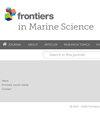Biogeochemistry of phytoplankton RuBisCO in the ocean
IF 3
2区 生物学
Q1 MARINE & FRESHWATER BIOLOGY
引用次数: 0
Abstract
Form I Ribulose-1,5-bisphosphate oxygenase/carboxylase (RuBisCO) is the most abundant enzyme on Earth, playing a key role in carbon fixation during oxygenic photosynthesis. Using published sequence data, I show that there are significant differences in the amount of elemental resources (C, N and S) and energy required to synthesize the different Types of Form I RuBisCO. The shorter amino acid lengths of cyanobacterial RuBisCO had lower resource requirements to build the holoenzyme compared with eukaryotes. Consequently, the rise to dominance of eukaryote phytoplankton during the Neoproterozoic (1000–541 Ma) led to a shift to more expensive eukaryote RuBisCO. There are also significant differences in the elemental composition of RuBisCO between eukaryotes in different supergroups. Estimates of resource allocation were used to estimate how much C, N and S is associated with RuBisCO in the modern ocean. The marine cyanobacterium海洋浮游植物RuBisCO的生物地球化学
1型核酮糖-1,5-二磷酸加氧酶/羧化酶(RuBisCO)是地球上最丰富的酶,在含氧光合作用过程中起着关键的固碳作用。利用已发表的序列数据,我表明合成不同类型的I型RuBisCO所需的元素资源(C、N和S)和能量有显著差异。与真核生物相比,蓝藻RuBisCO的氨基酸长度较短,构建全酶所需的资源较少。因此,在新元古代(1000-541 Ma),真核生物浮游植物的优势地位上升导致真核生物RuBisCO的转变。不同超群真核生物间RuBisCO的元素组成也存在显著差异。对资源分配的估计被用来估计现代海洋中有多少C、N和S与RuBisCO有关。海洋蓝藻原绿球藻是地球上数量最多的光合生物,占海洋净初级生产力的7.3 - 8.9%。原绿球藻中RuBisCO的含量为2.11 ~ 2.69 × 106 mol,占海洋中RuBisCO总量的4 ~ 5%。RuBisCO含量相对较低,表明原绿球藻具有较高的光合效率。总的海洋RuBisCO储层相当于0.016 Pg C, 5.1 Tg N和0.4 Tg S。估计RuBisCO的年产量相当于0.725 - 0.890 Pg C年-1,228-283 Tg N年-1,16.5 - 22.5 Tg S年-1。在海洋氮循环的背景下,每年通过RuBisCO池的氮通量相当于甚至高于生物固氮速率(223±30 Tg N yr−1)。RuBisCO的周转很快,每6.6 - 8.2天发生一次。综上所述,RuBisCO不仅是海洋中重要的主要固碳酶,而且是一个化学元素池,特别是氮。
本文章由计算机程序翻译,如有差异,请以英文原文为准。
求助全文
约1分钟内获得全文
求助全文
来源期刊

Frontiers in Marine Science
Agricultural and Biological Sciences-Aquatic Science
CiteScore
5.10
自引率
16.20%
发文量
2443
审稿时长
14 weeks
期刊介绍:
Frontiers in Marine Science publishes rigorously peer-reviewed research that advances our understanding of all aspects of the environment, biology, ecosystem functioning and human interactions with the oceans. Field Chief Editor Carlos M. Duarte at King Abdullah University of Science and Technology Thuwal is supported by an outstanding Editorial Board of international researchers. This multidisciplinary open-access journal is at the forefront of disseminating and communicating scientific knowledge and impactful discoveries to researchers, academics, policy makers and the public worldwide.
With the human population predicted to reach 9 billion people by 2050, it is clear that traditional land resources will not suffice to meet the demand for food or energy, required to support high-quality livelihoods. As a result, the oceans are emerging as a source of untapped assets, with new innovative industries, such as aquaculture, marine biotechnology, marine energy and deep-sea mining growing rapidly under a new era characterized by rapid growth of a blue, ocean-based economy. The sustainability of the blue economy is closely dependent on our knowledge about how to mitigate the impacts of the multiple pressures on the ocean ecosystem associated with the increased scale and diversification of industry operations in the ocean and global human pressures on the environment. Therefore, Frontiers in Marine Science particularly welcomes the communication of research outcomes addressing ocean-based solutions for the emerging challenges, including improved forecasting and observational capacities, understanding biodiversity and ecosystem problems, locally and globally, effective management strategies to maintain ocean health, and an improved capacity to sustainably derive resources from the oceans.
 求助内容:
求助内容: 应助结果提醒方式:
应助结果提醒方式:


